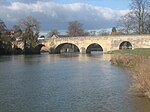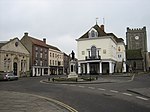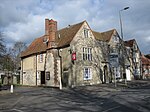Wallingford Castle

Wallingford Castle was a major medieval castle situated in Wallingford in the English county of Oxfordshire (historically Berkshire), adjacent to the River Thames. Established in the 11th century as a motte-and-bailey design within an Anglo-Saxon burgh, it grew to become what historian Nicholas Brooks has described as "one of the most powerful royal castles of the 12th and 13th centuries". Held for the Empress Matilda during the civil war years of the Anarchy, it survived multiple sieges and was never taken. Over the next two centuries it became a luxurious castle, used by royalty and their immediate family. After being abandoned as a royal residence by Henry VIII, the castle fell into decline. Refortified during the English Civil War, it was eventually slighted, i.e. deliberately destroyed, after being captured by Parliamentary forces after a long siege. The site was subsequently left relatively undeveloped, and the limited remains of the castle walls and the considerable earthworks are now open to the public.
Excerpt from the Wikipedia article Wallingford Castle (License: CC BY-SA 3.0, Authors, Images).Wallingford Castle
High Street, South Oxfordshire Winterbrook
Geographical coordinates (GPS) Address Nearby Places Show on map
Geographical coordinates (GPS)
| Latitude | Longitude |
|---|---|
| N 51.6029 ° | E -1.1221 ° |
Address
Wallingford Castle Walls
High Street
OX10 0BP South Oxfordshire, Winterbrook
England, United Kingdom
Open on Google Maps








